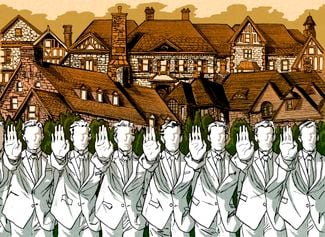

WHITE PICKET FENCE
Starting at age 5, Toney Goins traveled each morning from his family’s brick rowhouse in Philadelphia to school on the Main Line. Armored in a blue blazer and boat shoes, he bypassed the sprawling estates his great-great-grandmother used to clean and the golf club where Black families like his were not welcome until the 1990s. His destination was The Haverford School, a private school for boys.
As a student, Goins tried his best to pare away his Blackness. He longed to be like any other prep-school kid and erasing himself seemed a small price to pay. He learned to dress like the mostly white boys at school; he adopted their attitudes.
“I’ve been the very fortunate Black kid who’s able to – I won’t say infiltrate, but it kind of feels like infiltrate – these spaces,” he said.


A More Perfect Union is a special project from The Inquirer examining the roots of systemic racism through institutions founded in Philadelphia. Read the series →
The Main Line is home to Philadelphia’s old-money suburbs, where American royalty like the Pews and the Montgomerys once lived. Stretching from Overbrook to Paoli along the historic Pennsylvania Railroad, the place today is home to at least 11 country clubs, an annual horse show, and some of the best public schools in the country.
Immortalized in movies like The Philadelphia Story and Grease, the Main Line helped to shape what we think of when we imagine the suburbs; Betty Draper, the quintessential American housewife of Mad Men, grew up in Lower Merion.
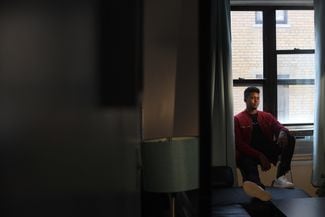
But the advantages that accrued to the mostly white people here, both in the movies and in real life, were never intended for Goins or his family. In Haverford Township, where Black people make up just 3% of the population, you can practically feel the history looming.
From the redlining practices lenders used as early suburbs grew, to agreements that banned people of color from purchasing certain homes, America’s suburban landscape can’t be severed from its racist roots. Nor can the yawning wealth gap between Black Americans and white Americans.
Yet Goins’ great-great-grandfather Earlie Jenkins did buy a home on the Main Line. He became part of a small but thriving middle-class Black community that remains today. In reporting the family’s story, The Inquirer also uncovered previously unreported racial restrictions that covered a swath of Haverford Township, including a 200-lot whites-only subdivision, directly across the street from the home that Jenkins purchased.
The family’s experience illuminates the complicated legacy of racial exclusion on the Main Line. Because despite racial covenants that blocked Black people from buying area homes in the 1920s, the Jenkinses did not endure a single, static theft.
Instead, over five generations, they had to reckon with ever-mutating forms of theft and exclusion. They rooted and organized and built their own history. Jenkins worked in the cafeteria of the school that his great-great-grandson graduated from. From all appearances, the family achieved suburban prosperity — but a tenuous, bounded version of it.
“It’s like they open the door and show you the other side,” Goins said. “But they won’t let you go in.”
‘Your Investment Will Be Protected Forever’
Earlie Jenkins badly wanted his children to get a better education than he did. So when he got a letter from his brother promising a better job on the Main Line, he bid goodbye to the North Carolina farming town where he grew up and set off for the North with his wife and three children. He had never gone to school past the fifth grade; he refused to see the same thing happen again.
Soft-spoken, with a slight Southern drawl and gray-green eyes, Jenkins arrived in 1929, at a moment of great opportunity on the Main Line. Jenkins was one of tens of thousands of Black people streaming into Greater Philadelphia for a chance. Town officials prided themselves on creating a place that would serve as a beacon of good fortune not just for Philadelphia, but for the country.
“Those of us who live here can scarcely realize how profound an impression is made upon the foreigner or even upon the visitor from other parts of America as he is driven mile after mile past places where there is no jarring note of ugliness,” a 1919 housing report commissioned by the Main Line Citizens’ Association said.
As similar suburbs sprang up across the country over the next few decades, Black families like the Jenkinses were “effectively shut out” of the bounty, said Andre M. Perry, a senior fellow at Brookings Metro who studies structural inequity.
Immediately upon arriving, Jenkins could see that the path forward would be uneven. He moved his family into a two-bedroom apartment above a store in Bryn Mawr; the five Jenkinses slept in one room, renting the other out to save money.
Soon Jenkins found work as a cook at The Haverford School, a prestigious private school for the sons of the Main Line elite. Photos from the time show him in the cafeteria in a starched white uniform, his chef’s hat tilted to the side.
Jenkins’ wife, Roxanna, an inventive woman with a mathematical mind, found work cooking and cleaning for a white Main Line family. She took the jobs that were available to her — the vast majority of Black women in the paid workforce in Ardmore listed their employers as “private families” in 1920, according to a dissertation analysis by Trecia Pottinger.
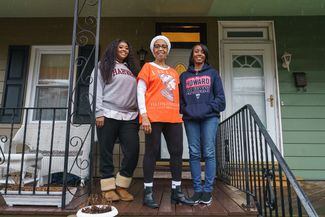
Earlie Jenkins had migrated 400 miles north, crossing the Mason-Dixon Line, to settle in the Philadelphia suburbs. But still, his family worked for white employers and went to white schools and paid a white landlord. That was a perilous position to be in. In 1940, all the Black families in the apartment building where the Jenkinses lived were kicked out, according to LaDoris Cordell, Jenkins’ granddaughter, a retired judge who lives in California. The family referred to it as “the Great Eviction.”
As the Jenkinses packed their boxes once again, a savvy developer named Frank H. Mahan had recently finished building “sturdy, modern, semi-detached homes” for families just two miles away. But though he advertised them widely, they were not available to the Jenkinses.
“The said premises shall not be sold to, owned, used or occupied by any person or persons other than those of the Caucasian race,” read deeds from the mid-1920s that The Inquirer uncovered on a subdivision in Haverford Township covering 200 lots. The Inquirer also identified another Mahan subdivision, Golf Villa, blanketed in racial restrictions.
Finding such restrictions, which remain on the books both in Haverford and around the country, is a painstaking process that requires manually combing through handwritten deeds. A comprehensive survey of racial restrictions on the Main Line has never been done; local officials said they weren’t aware of those found by The Inquirer.
“It's kind of disgusting that those racial restrictions were written into deeds,” said David Burman, Haverford Township manager. “From my perspective, they're private documents. [We] can't control them as a municipality.”
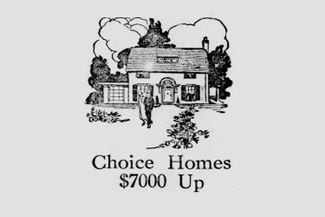
'Wisely Restricted'
Deed restrictions, though, were a sinister public-private partnership. The National Association of Real Estate Boards, in collaboration with the U.S. Department of Commerce, drafted a model racial covenant in 1927 and encouraged real estate agents to deploy similar ones across the country. Homeowners associations joined in, too.
Though the Supreme Court found them unconstitutional in 1948, they were practically everywhere by then.
A recent study by the Federal Reserve Bank of Philadelphia found nearly 4,000 racial covenants in the city between 1920 and 1932. In St. Louis, the Urban League determined that only 35 newly built homes out of 70,000 were available to Black residents between 1947 and 1952, according to Jeffrey Gonda’s book Unjust Deeds.
Across the country, covenants were used as a marketing tool to attract white homebuyers.
“Here’s this new subdivision: It has green space, it has curving streets, it has homes that cost a certain amount, and it’s also racially restricted, so your investment will be protected forever,” said Kirsten Delegard, one of the cofounders of the Mapping Prejudice Project at the University of Minnesota, which has mapped 25,000 covenants across Hennepin County.
That’s precisely what Mahan did. “Build Your Home … Wisely Restricted,” he advertised in The Inquirer in 1923, referring to the racially restricted Golf Villa.
By 1930, Mahan lived in a house valued at around $200,000, according to census records — about $3.4 million in today’s dollars. Though he would not sell the homes he was building to Black buyers, he did share a home with four Black employees: a cook, a servant, a gardener, and a chambermaid.
Mahan had seven children, and some of his grandchildren remain on the Main Line today.
When contacted by The Inquirer about the racial restrictions in her grandfather’s deeds, Robin Mahan Conicella declined an interview.
“1925 is nearly 100 years ago. A bad time in history,” Conicella said. “I don’t think it’s best for me to interview with someone who wants to explore a bad time in history.” She added, “Women have come so far.”
Make More Possible
Show your support and help our journalists continue to make important work like A More Perfect Union possible with a tax-deductible gift.
Subscribe to The Philadelphia Inquirer
To support more accountability journalism, consider subscribing today.
Mahan’s covenants seemed to act as a kind of firewall.
“The Black population was already really established on the Lower Merion side. These might have been steps taken to prevent the expansion of it,” said Craig Bailey, a Villanova University professor who is writing a book on the development of the Main Line along racial lines.
Bailey found that Ardmore developers, including Mahan, built roads in the 1910s and ’20s encircling the area where Black people settled. Developers used the roads to create a physical barrier between Black neighborhoods and the homes they were building nearby, in order to increase their profits, Bailey said.
Faced with multiple firewalls, Earlie Jenkins’ neighbors and friends told him that homeowners on Aubrey Avenue in Haverford Township didn’t typically sell to Black families. But Aubrey Avenue was becoming a racially mixed block in a mostly white town by the 1930s.
And so in 1942, Jenkins got his chance. He paid $100 up front for a $3,200 home, according to deed records. The Inquirer did not find a racial restriction in the deed.
He had come a long way from the farm on the banks of the Roanoke River — but if he gazed across the street, Jenkins could see the rows and rows of brand-new suburban houses, built by Mahan, that he was not allowed to buy.
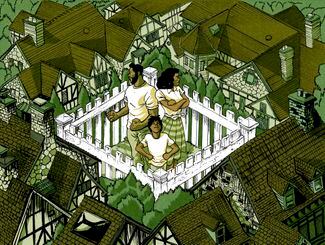
The house on Aubrey Avenue
The marriage of Clara Jenkins, Earlie’s middle daughter, to Lewis Hazzard in 1944 was the social event of the season, according to a story about the wedding in The Pittsburgh Courier, a national Black newspaper. Clara, sharp and meticulous with a dry sense of humor, was “lovely in a gown of white taffeta.”
She and her new husband were popular — at least, on the Black Main Line. Their social world was entirely segregated.
At first, the Hazzards hoped to buy their own place nearby. But Jenkins persuaded them to buy the house from him on Aubrey Avenue, said his granddaughter Roxanna Wright, who is now 76. He was determined to keep it in the family.
“For him to get that house, what he went through — it was very important to him,” Wright said.
The house, though nothing like the grand estates the Main Line is known for, had a verdant backyard that Clara Hazzard planted with daffodils, tulips, and hydrangea bushes. In the living room she hung lace curtains; on Sundays, she baked corn pudding and roast chicken for formal supper after church.
The Hazzards took in friends and relatives, some of whom stayed for years, Wright said. Hazzard hung her children’s diplomas and awards along one wall of her family room.
“It was a thing of dignity,” said Wright. “She said, I want you to see ... that there's a history to what has happened.”
Lewis Hazzard was outspoken as president of the Ardmore Progressive Civic Association. But though quieter than her husband, Clara Hazzard was also a fierce organizer. She often hosted NAACP meetings at the house or at her husband’s business, Spring Cleaners. Having inherited her father’s obsession with education, she was particularly disturbed by the local elementary school, Ardmore Avenue School, where mostly Black children used textbooks stamped “discard” and played in a parking lot instead of a playground. She helped organize to shut it down, thereby integrating the other elementary schools nearby.
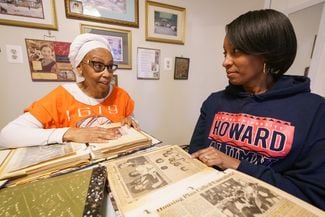
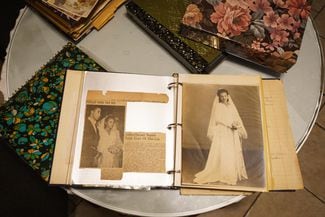
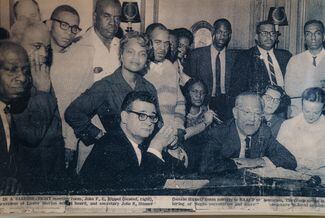
Sometimes, Hazzard fought back in smaller ways. When Wright was a student at Haverford Junior High School, she auditioned for the cheerleading team. But the white faculty told her she couldn’t join — they had run out of pleated skirts. Upon hearing the news, Hazzard drove to South Philadelphia, bought red wool, and returned home to hand-stitch the uniform herself. On the first day of cheerleading practice, Wright wore black-and-white shoes that almost matched the ones the white girls wore.
Now tell me, Wright recalled Hazzard saying, why can’t my daughter join the cheerleading team?
Generation Priced Out
Carla Garrison, Wright’s daughter, was often the only Black student in her classes at Welsh Valley Middle School, a public school in Narberth with its own soccer fields and tennis courts. Like her mother and grandmother before her, she tired of the responsibility sometimes, of being the one all the other children turned to when the teacher mentioned slavery.
But still, Ardmore was home. She loved the annual Memorial Day parade, when three drill teams competed in front of the American Legion; she returned summer after summer to the camp at the Ardmore Avenue Community Center, which everyone calls the Soul Shack.
After graduating from Howard University, she intended to return to the Main Line for good. She wanted to buy a home of her own in the place where her family had lived for so long.
But by the early 1990s, the houses in Haverford and Lower Merion were far too expensive for a first-time homeowner without family help. Last year, the median sale price in Haverford topped $850,000 according to PropertyShark.
So Garrison left, at least technically. She gave up the excellent public schools, the leafy streets, the idea of living within walking distance to her church. She bought a rowhouse in Overbrook Park, across the Philadelphia city line, on a narrow residential block where the neighbors bring each other flashlights if the power goes out.
Distanced now from the place she grew up, Garrison brought her two children back to Ardmore almost every day. The door to the house on Aubrey Avenue was always unlocked; the family joked it should be called Hazzard Headquarters.
When the time came to choose schools for her children, Angel and Toney, Garrison made the same choice that her great-grandfather did decades earlier. They had to get a good education and, as far as she could see, the only option was private school on the Main Line. Her children would be among the only Black students there; education in her family had always required sacrifice.
Garrison just wasn’t sure which was harder to witness: Angel, who struggled to fit in at the Shipley School, or Toney, who fit in so well at Haverford Garrison worried he might disappear.
Leaving the Main Line
Toney Goins now remembers his time on the Main Line with a hint of bewilderment. Did he really wear pastel shorts and Dockers? He rarely invited friends to his house; not after seeing their mansions and pools. For a long time, he assimilated so well into the places they lived that he wasn’t fully aware of the toll.
“I had a very inherently negative reaction toward Black people for a very long time growing up,” Goins said recently. “I would look down on them. I would consider myself better than them. … Even, I wasn’t attracted to Black women because of that.”
After graduation, he got into the Juilliard School to study acting. It was only when he left the Main Line that he felt he stopped playing a role.
Now he gets paid to act as a hedge fund manager on the TV show Billions.
Clara Hazzard sold the home on Aubrey Avenue to another Black family in 2015. But even the sale of the beloved house didn’t result in the kind of bounty white families experienced nearby. It sold for $210,000; the typical home in the neighborhood sold for about $100,000 more than that, according to Zillow.
Hazzard died in January 2020. Garrison wears her grandparents’ rings on a gold chain around her neck. She tries not to drive by Hazzard Headquarters, wary of the ache it brings.
Wright, Hazzard’s daughter, still lives in her home on Holland Avenue in Ardmore, in a part of town that was majority-Black 100 years ago, though the Black population has dwindled in the last three decades. Back in 1919, town officials described her Main Line neighborhood as one of those “spots easily avoided on a sight-seeing trip, but contain[ing] a part of the population essential to the comfort and well-being of the rest.”

For its part, Haverford Township has enlisted a consulting firm to advise on equity issues. The police department has undergone antiracism training, which included watching the documentary Walking While Black: L.O.V.E. Is the Answer and a facilitated discussion, Burman, The Haverford Township manager, said.
Burman was struck in the most recent census by how white the township is. The deed restrictions help make sense of that, he said.
In May, Wright and Garrison will travel to New York to see Goins in a new play called Exception to the Rule.
Goins could probably afford to move back to the Main Line. He’s only 26; he’s paid TV money.
But he says he will not settle here. He spent his whole life trying to prove that he wasn’t, as he put it, “the common Negro.” He paid attention to the way he spoke, the way he carried himself, how well he did in school.
He learned to infiltrate — then he had to go.
Acknowledgement
A More Perfect Union is produced with support from The Lenfest Institute for Journalism, Lisa D. Kabnick and John H. McFadden, Peter and Judy Leone, and Surdna Foundation. Editorial content is created independently of the project’s donors.
We Want To Hear From You
Do you have questions about this chapter, or A More Perfect Union? Let us know your thoughts.
Watch the latest edition of Inquirer LIVE’s “A More Perfect Union” series: White Picket Fence on Tuesday, May 10 at 4:15 p.m. Moderated by Deputy Editor, Ariella Cohen, the livestreamed event will delve into the complicated legacy of racial exclusion on the Main Line. The discussion will include this installment’s writer, Zoe Greenberg, in conversation with longtime Main Line resident Roxanna Wright and Andre M. Perry, a Brookings Metro scholar studying structural inequity. Register for the event here.
Staff Contributors
- Reporter: Zoe Greenberg
- Sidebar Reporter: Jake Blumgart
- Deputy Editor: Ariella Cohen
- Contributing Editor: Errin Haines
- Research Director: Brenna Holland
- Managing Editor of Visuals: Danese Kenon
- Design Director: Suzette Moyer
- Creative Director: Dain Saint
- Developers: Dain Saint, Sam Morris
- Illustration: Derick Jones
- Photography: Jessica Griffin, Jennifer S. Altman
- Graphics: John Duchneskie
- Project Manager: Ann Hughes
- Digital Editor: Patricia Madej
- Audience: Erin Gavle
- Copy Editor: Richard Barron